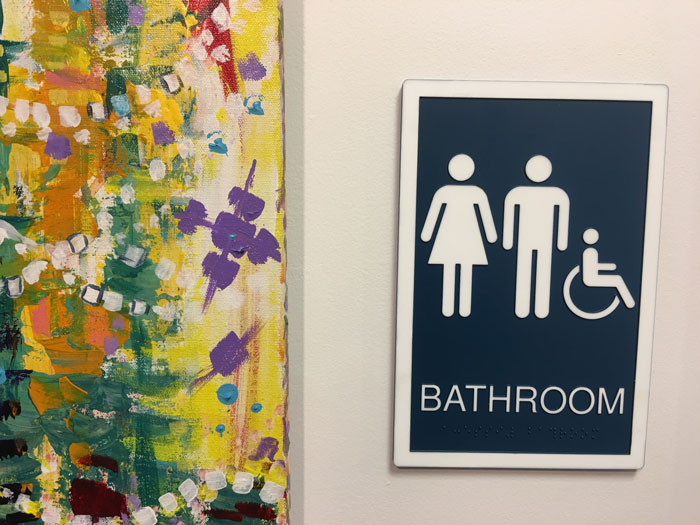The Ultimate Guide to ADA Bathroom Signs: Compliance, Design, and Installation
Ensuring accessibility for all is essential for modern businesses, especially when it comes to bathroom signage. ADA (Americans with Disabilities Act) regulations set specific requirements for bathroom signs to ensure inclusivity and easy access for individuals with disabilities. In this guide, we’ll cover the basics of ADA bathroom signs, design considerations, and tips for proper installation to keep your business compliant and accessible.
Why ADA Bathroom Signs Matter
ADA bathroom signs do more than indicate restroom locations; they serve as an important accessibility tool. By following ADA guidelines, you help people with visual impairments, physical disabilities, and other challenges to independently locate and access bathrooms in your facility. Non-compliance with ADA signage regulations can result in legal consequences, but it also reflects poorly on a business's commitment to inclusivity,
Key ADA Requirements for Bathroom Signs
Here are the main ADA guidelines that bathroom signs must follow:
- Braille and Tactile CharactersAll ADA-compliant bathroom signs must include braille and tactile (raised) characters. The tactile characters should be in uppercase and sans-serif or simple serif fonts to maximize readability.
- Character Height and SpacingADA regulations require specific character heights, usually between 5/8 inch and 2 inches, depending on the viewing distance. Proper spacing between characters is essential for readability, especially for visually impaired individuals who may use their fingers to read tactile text.
- PictogramsRestroom signs should include easily recognizable symbols, such as the classic "Men" or "Women" figures, or an icon for unisex bathrooms. Pictograms should be 6 inches tall and enclosed in a contrasting background.
- Color and ContrastHigh contrast is necessary for ADA-compliant signs, ensuring text and symbols stand out from the background. A general rule is to use light-colored text on a dark background or dark-colored text on a light background.
- Sign PlacementADA bathroom signs must be mounted at a height between 48 and 60 inches from the floor to the bottom of the sign, usually on the wall adjacent to the door’s latch side. This placement ensures they are accessible to individuals in wheelchairs and those with visual impairments.
- Non-Glare FinishSigns should have a matte or non-glare finish to improve visibility under different lighting conditions. Glossy finishes can cause glare, making it difficult for individuals with visual impairments to read the sign.
Types of ADA Bathroom Signs
- Gender-Specific Bathroom Signs: For designated male and female restrooms, ADA signs include the respective pictograms, raised text, and braille.
- Unisex or All-Gender Signs: These signs help accommodate non-binary and transgender individuals, as well as parents with children of a different gender.
- Accessible Signs: Restrooms with accessible stalls need a wheelchair symbol on the sign to indicate accessibility.
Tips for Designing ADA-Compliant Bathroom Signs
Creating ADA bathroom signs that are both compliant and visually appealing can seem challenging. Here are some design tips:
- Keep It Simple: Stick to clean, bold fonts and universally recognized symbols.
- Choose Contrasting Colors Wisely: Black and white, navy blue and white, and dark brown and beige are popular high-contrast combinations.
- Make Symbols Clear: Using universally recognized icons for men, women, and accessible restrooms ensures that your signage is easy to understand at a glance.
- Maintain Brand Cohesion: ADA signs don’t have to be dull—incorporate brand colors and fonts as long as they don’t compromise compliance.
Installation Tips for ADA Bathroom Signs
When installing ADA-compliant bathroom signs, following these placement guidelines will keep your business in compliance:
- Mounting Height: Ensure the bottom edge of the sign is between 48 and 60 inches from the floor. For braille signs, the tactile characters should fall within this range.
- Correct Side of the Door: Place the sign on the wall to the latch side of the door, not on the door itself, so it remains accessible when the door is open.
- Double-Check Location with a Guide: Using an ADA compliance guide or a professional installer familiar with ADA regulations is helpful to ensure accurate placement.
Benefits of ADA Bathroom Signs Beyond Compliance
Investing in ADA-compliant signage has benefits beyond legal compliance. Some of the key advantages include:
- Enhanced Customer Experience: Accessible signs create a welcoming environment for all customers, boosting your brand's reputation.
- Improved Navigation: ADA-compliant signs help everyone, including individuals without disabilities, find their way around your facility.
- Positive Brand Image: Demonstrating a commitment to accessibility showcases your company as responsible, modern, and caring.
- Broader Customer Base: Inclusivity in design helps attract a more diverse audience and caters to a wider range of customers.
Conclusion
ADA bathroom signs are a crucial component of an accessible business environment. By following ADA requirements in design, color contrast, symbol usage, and placement, you ensure your space is welcoming, inclusive, and legally compliant. Beyond meeting regulations, ADA-compliant signs send a message that your business cares about accessibility and inclusion.
By investing in high-quality ADA bathroom signage, you're not only enhancing the functionality of your space but also building a reputation as a business that values inclusivity and customer experience.

Comments
Post a Comment